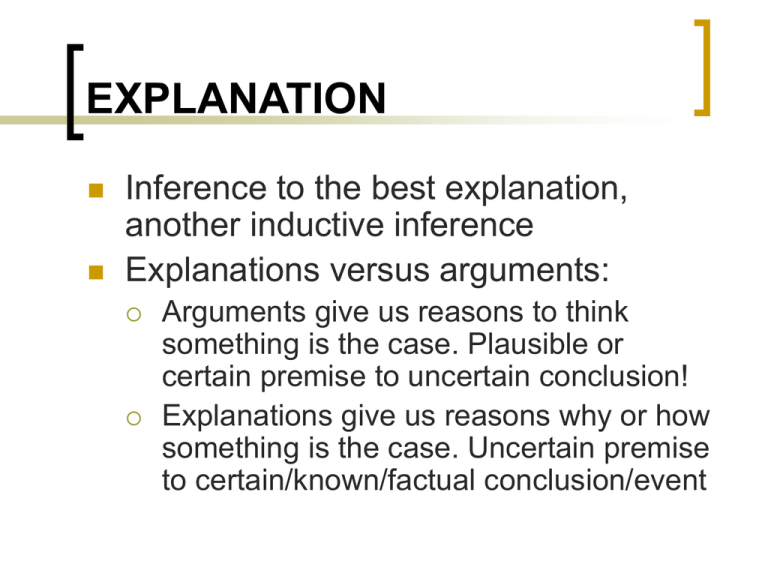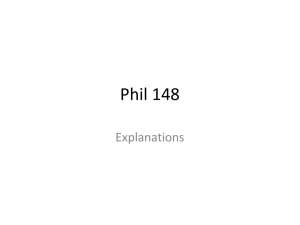EXPLANATION
advertisement

EXPLANATION Inference to the best explanation, another inductive inference Explanations versus arguments: Arguments give us reasons to think something is the case. Plausible or certain premise to uncertain conclusion! Explanations give us reasons why or how something is the case. Uncertain premise to certain/known/factual conclusion/event TYPES OF EXPLANATIONS Procedural (how something is done) Interpretive (why something means what it does) Functional (how something works or functions) Theoretical (why something is the way it is, why something happened) THEORETICAL EXPLANATIONS The focus of our analysis Pattern of reasoning: from premises about a state of affairs (what we know to have happened) to a conclusion about why this happened. Best Explanations: We often have competing, alternate, comparable theories or explanations. We assess which is the best, most plausible, most likely to be true. PATTERN OF INFERENCE More formally, the pattern: Phenomenon Q E provides the best explanation for Q Therefore, E is probably true Informal: we do it naturally! When we evaluate whether is does provide best explanation, we use criteria PARTS OF EXPLANATION Explanandum: what is being explained, the phenomenon Q Explanans: the answer or statement that explains the explanandum The explanans tries to explain the explanandum by positing or providing a theory Sometimes requires imagination to formulate the theory Theories expand our knowledge and enable it further BEST EXPLANATION Some basic starting points for determining which of several explanations is best If you formulate a new or novel one and do not compare it to others, greater likelihood of it being false If other explanations are just as good as yours, this sheds doubt on yours If you study and research your explanation, greater likelihood that it will be plausible OBSERVATION We often observe our surroundings to determine which of any proposed theories is best i.e., process of determining why your car won’t start. Battery dead Empty fuel tank Bad starter Vandalized, etc PROCESS OF ELIMINATION Using observation to eliminate theories Using background knowledge, if any Notice, we fill in premises to support why any explanation is best THEORIES Used in all academic departments and many areas of life, courts, etc. Organizing tools to help us understand Constructs, but not arbitrary Theories are inherently open to revision, refutation and further confirmation Theories are often causal (science) SOME EXERCISES 9.2 p. 341 Perhaps first in 9.5 TESTING OR EVALUATING THEORETICAL EXPLANATIONS Why do we need to determine which theory is better? Minimal requirement: consistency Consistency must be internal and external Non-contradiction, non-opposition External consistency also includes completeness! It cannot fail to include essential parts of explanandum THEORY CHOICE, cont. Minimum requirement cont. Incompleteness not effective when other explanations are absurd Possibility of infinite number of explanations (theory is “underdetermined”, evidence does not dictate what theory is best) Quantity of evidence: a good indicator of which theory is better or best ADEQUACY If theory meets consistency requirement, it is eligible for further testing. If not, it can be scrapped! Careful: not refutational The criteria for adequacy Testability Fruitfulness Scope Simplicity Conservatism TESTABILITY Requires that there is some way or method to determine whether theory is true or false. Do all components of theory have to be testable, or only the whole theory? Soul theory of personal identity, Plato Theory of witches, moral theory of disease TESTABILITY AND PREDICTIONS Theories are testable when they make prediction of some event or effect or phenomenon other than event to be explained Sometimes prediction can be a consequence or outcome If theory does not do this or predicts the obvious, we have reason to doubt it. Novelty! FRUITFULNESS Theories are more adequate than others if they predict novel events or phenomenon Fruitfulness also includes ability to encourage new research or open up new areas of research Novel predictions: surprising ones! Karl Popper and criteria for genuine scientific theories Einstein’s theory and its novel predictions: light around objects appears bent due to curvature of space SCOPE How much does the theory explain or predict? If one theory can explain and predict more than another, that theory is to be preferred over the other. Explaining more diverse phenomena Newton’s theory explained more than Aristotle’s, Einstein’s more than Newton’s, etc. SIMPLICITY Ockham’s razor and parsimony Theory which makes the fewest assumptions is to be preferred over others Notice, comparative nature of theory choice. NO GUARANTEES Conspiracy theories: too many assumptions which require evidence I.E., creationism: assumes the existence of a creator. But, simpler in other ways! Ad hoc or auxiliary hypotheses: simplicity is compromised when these are added to “save” a theory CONSERVATISM A theory which contradicts or goes against our established knowledge or beliefs is more likely to be implausible Background knowledge A warning against novelty! But… Claim: Vitamin C cures cancer! Claim: I have made a perpetual motion machine, or I have produced cold fusion! Claim: Dowsing or Divining for water works! SOME CAVEATS FOR CRITERIA No strict formula. Sometimes one criterion is weighed more than others Cannot be used to silence or discourage radical departures Paradigm shift Criteria is not a proof, only a diagnostic tool, requiring good judgement Non-subjective: judgement vs taste! TEST OR T.E.S.T. A fully assessment of which explanations is the best At the end of the test, we must state which theory is the most plausible, the best… A procedure that requires all the tools of critical thinking that we have examined TEST, cont. Step 1: State the theory and check for consistency Step 2: Assess the evidence, either presented or not Step 3: Scrutinize alternative theories. Step 4: Test the theory using criteria of adequacy STEP ONE State theory in a clear, concise fashion Apply consistency test (is it eligible for further assessment?) STEP TWO Evidence? What evidence is given? Is it reliable, does it commit fallacies, is the source credible, does it suffer from a causal confusion, is it consistent with background knowledge or specialized knowledge? Is there evidence disconfirming the theory? STEP THREE Scrutinize alternative theories. Might have to formulate or look for them (thinking outside box) Goes against our grain, our tendency to identify with a favorite theory Using alternative theories for applying criteria. If we miss this, we cannot take last step!! STEP FOUR Complete test by applying criteria of adequacy. Remember to apply all 5. Examples on pages 364-68 are instances of response examples, how to apply the full test Problem of background knowledge! How much can you be expected to know? Yardstick: what would you need to know to be able to judge evidence or fully apply adequacy criteria.







